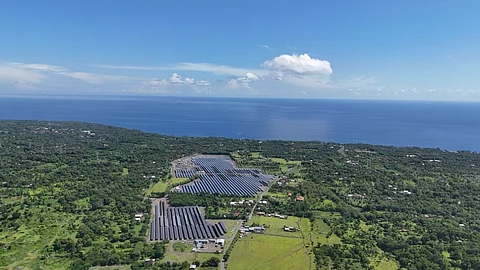

Indonesia targets 108.7 GW solar capacity under RUKN 2025–2060, forming 24.6% of the total electricity mix
IESR urges a domestic solar roadmap to reduce import reliance and boost the industrial ecosystem
Despite the current 10.6 GW module capacity, low demand and missing upstream components limit utilization
IESR proposes phased PV supply chain growth with policy support and FDI for technology transfer
Indonesia targets to achieve up to 108.7 GW of solar capacity under its 2025–2060 National Energy Policy (RUKN). This policy aims for new and renewable energy with storage to account for close to 41.5% of the planned 443 GW power generation capacity. With this share, solar energy will be the largest renewable energy source in its mix, representing approximately a 24.6% share.
Wind power plants, with a combined 73.5 GW, will account for an estimated 16.6%, and hydro power plants 0.3% with 1.4 GW. The Ministry of Energy and Mineral Resources (ESDM) estimates that the country will require close to 9.6 GW of additional power plant capacity every year to meet these targets, as the existing power plants require replacement. The ministry estimates the country’s total solar energy potential stands at approximately 3,315 GW.
Even though the ambition may seem ‘vague’ today, the Institute for Essential Services Reform (IESR) supports the goal, while calling for a comprehensive roadmap to build a resilient domestic solar industry and reduce reliance on global supply chains.
Over 100 GW of solar power capacity will mean a growth over the 942 MW solar PV capacity the country had installed by the end of 2024, according to the International Renewable Energy Agency (IRENA). Under its Electricity Supply Business Plan for 2025-2034, Indonesia aims to add 17.1 GW of solar capacity (see Indonesia To Add 42.6 GW Renewables By 2034 Under RUPTL). Additionally, IESR adds that the country also plans to export a capacity of 3.5 GW AC to its neighbor, Singapore.
With all of the above, there is expected to be much demand for solar power in Indonesia. Yet, the country lacks an ecosystem to support this targeted growth for solar in terms of an upstream industrial setup.
Indonesia already produces 10.6 GW of solar modules and 9.5 GW of solar cells at home, but there isn’t enough domestic demand, which means low-capacity utilization, points out IESR.
Moreover, there is a serious lack of domestic production of polysilicon, ingots, and wafers, as well as low-iron tempered glass. This is despite the fact that this Southeast Asian nation is blessed with over 17 billion tons of quartz sand across Sumatra, Kalimantan, Sulawesi, and Nusa Tenggara, stresses the institute.
Using its domestically available resources, along with the availability of labor, industrial zones, and renewable energy potential, Indonesia can reduce polysilicon production costs, which currently reach up to $8 to $9/kg. Beyond the borders, international demand for solar energy can make Indonesia an alternative to China for the PV supply chain.
“Countries in Asia, Europe, Africa, and Latin America are now seeking alternative supply chains, with logistics efficiency as a key consideration. Indonesia, located at the heart of Southeast Asia with access to Asia and the Pacific, has a significant opportunity to position itself as a solar power plant production hub in the region,” said IESR CEO Fabby Tumiwa.
To help Indonesia make the most of this opportunity to make solar a well-established industry, the IESR says it has developed a Roadmap for an integrated Photovoltaic Industry Supply Chain in Indonesia in collaboration with the Indonesian Institute of Technology (ITI), and the National Research and Innovation Agency (BRIN).
The study proposes that the country develop its PV industrial supply chain in 3 stages: 2025-2030, short-term; 2031-2040, medium-term; and 2041-2060, long-term.
These efforts will need to be backed by strong policy support, including fiscal incentives, harmonized import duties, local content pricing preferences, and regulatory reforms to boost solar manufacturing and advance projects like the green corridor to Singapore.
The government should also provide a clear roadmap and attract foreign direct investment (FDI) to enable technology transfer and innovation-driven partnerships, recommends IESR.
